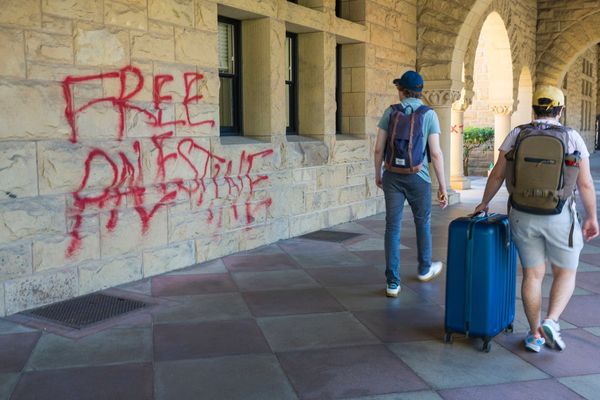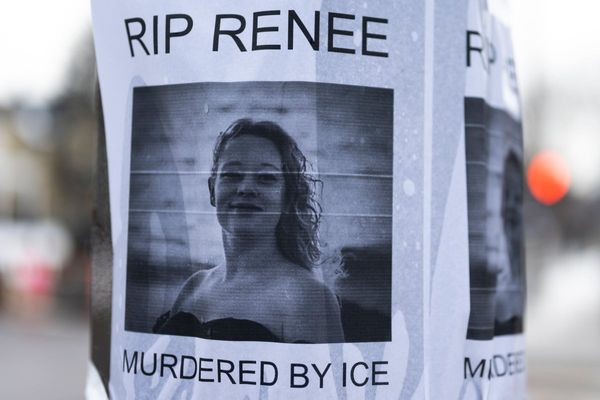
In the third hour of the 18th day in constable Zachary Rolfe’s trial for murder, the Northern Territory police officer who had so far sat masked and mute in the courtroom was thrust into the fray.
“Your honour, my client does propose to give evidence in his defence and we’re in a position to start now, if that’s convenient to the court?” David Edwardson QC said on Wednesday.
After Judge John Burns confirmed it was convenient, Edwardson said: “I call Zachary Rolfe”.
Rolfe, a short man with an upright gait, had spent most of the week in the witness box, perched on the edge of his seat. Since the start of the trial, he has let his stubble grow.
During the trial, Rolfe’s voice had hitherto only been heard when audio from body-worn camera footage considered central to the case boomed throughout the courtroom from televisions overhead, and when he said “not guilty” at the start of the trial.
His evidence is the first time he has detailed why, on the night of 9 November 2019, he shot Kumanjayi Walker three times while trying to arrest him in the remote community of Yuendumu.
Burns told the court that although Rolfe had thus far maintained his right to silence by not participating in police interviews, they should not draw any unfavourable conclusions from that.
During his evidence, Rolfe turned side to side while speaking, making an effort to face the eight men and five women in the jury who have been separated to opposite walls of the court to mitigate a potential Covid-19 outbreak.
He started with the broad brushstrokes of his life: he was born in Canberra in 1991, completed high school there, joined the Army, where he spent five years from 2010 onwards, and then spent 10 months doing “odd jobs” in Canberra before joining the NT police.
He later clarified that during this 10-month period he also spent four to five weeks training in the US state of Arkansas with Trojan Securities International, where he completed hostage rescue, counter ambush driving, and weapons familiarisation courses to “upskill” himself.
In May 2016, he moved to Darwin to start his training with the NT police force.
He spoke about the breadth and detail of his police training. How he first became aware of an incident in which Walker used an axe to threaten two Yuendumu police officers who were trying to arrest him (“Kumanjayi Walker was lucky that he didn’t get shot that day”). And how Rolfe happened to come face to face with Walker in a dark room of a Yuendumu property known as House 511 only 15 minutes after leaving the local police station.
But Rolfe’s evidence was mostly about the 3.1 seconds that it took for him to shoot Walker three times.
Prosecutor Philip Strickland SC said in opening his case that Rolfe had no legal justification for firing the second and third shots, and given that they were fired from point blank range, Rolfe intended either to kill or seriously harm Walker.
As Edwardson said in his opening to the case, Rolfe’s defence is that he was acting in good faith, in the reasonable performance of his duties, and in the self-defence of himself and Eberl when he fired the shots at Walker.
“What is not in dispute … is that in the face of that spontaneous attack with an edged weapon, constable Rolfe was justified in drawing his police firearm and firing a shot into the back of Mr Walker – shot one,” Edwardson previously told the court.
“What is in dispute is whether, within the space of a couple of seconds, the subsequent discharge of two further shots into Kumanjayi Walker was unlawful.
“It is the defence position that constable Rolfe, having been stabbed by a known violent offender and having lawfully shot him once, was justified in continuing to defend his mate and fellow police officer who was just doing his job.”
What Edwardson had not said during his opening was in many ways the most fascinating part of Rolfe’s evidence this week: that the police officer claims Walker had his hand on his firearm, seemingly in an attempt to take it from him, only moments before the first shot was fired, and that he saw Walker stabbing Eberl in the chest and neck when shots two and three were fired.
Rolfe later agreed that camera footage did not show the hand resting on his gun, and he did not think it showed Eberl being stabbed. He also clarified that it was his “impression” and “perception” that Eberl was being stabbed, and that he had not physically seen Walker’s scissors touch his body.
Eberl was found to have a small scratch under his left shoulder several days after the incident, but he has given evidence that he could not recall this injury having occurred during his struggle with Walker.
Under cross-examination from Strickland, Rolfe denied that he had made up that Walker touched his gun or that he had seen him stabbing Eberl, and other parts of his evidence, or that he had rehearsed answers.
When these claims were put to him by Strickland, Rolfe answered “incorrect”.
Strickland was building to what he considers a singular point, that he believed was best emphasised by playing to the jury Rolfe’s own words from immediately after the shooting, which can be heard in the body-worn camera footage.
Rolfe told Eberl the shooting was “all good” as he had been stabbing them both.
Strickland said Rolfe answered Eberl in that way to justify what he had done, knowing the shooting had been captured on body-worn cameras.
“Because constable, you knew you had gone too far?” Strickland asked.
“Incorrect,” Rolfe answered.
“You knew you had been too gung ho,” Strickland said.
“Incorrect,” Rolfe said.
Strickland then asked Rolfe: “How was the situation all good?”
“A violent offender was trying to murder two police officers and he no longer was,” Rolfe responded.
Soon after that, and after a few more questions from Edwardson, it was over.
Rolfe stood at the stand, took a long sip from a plastic cup of water, and then made his way back into the body of the court, removing his mask from his left pocket and placing it over his face as he went.
The trial will continue on Tuesday.







